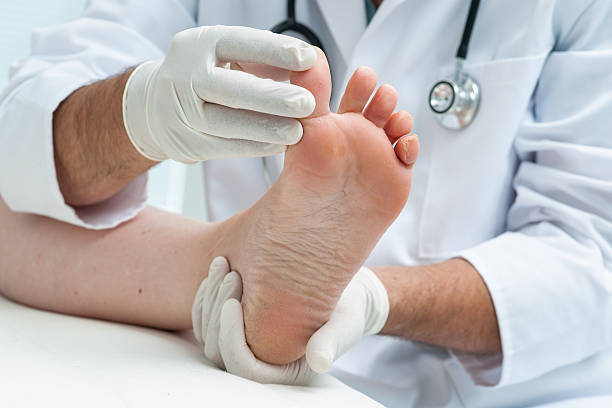If you have scaly, peeling skin between your toes or yellowish, thickened nails that itch, you may have a fungal infection. Infections of the skin and nails, called tinea pedis or onychomycosis, are usually mildly contagious and respond well to over-the-counter antifungal medicines.
Infections in the foot can be serious and should always be seen by podiatrist. They can result in amputation, cellulitis or bone infection (osteomyelitis).

1. Bacterial Infections
Bacteria are microscopic single-cell microorganisms that live in the body and in many of the things we come into contact with. Bacteria can cause a wide range of infections in different parts of the body. Infections caused by bacteria can be either acute or chronic.
Acute bacterial infections may be very painful. They may also be contagious. Bacteria can be passed from person to person by direct skin-to-skin or mucous membrane contact, through airborne or droplet transmission, or by vectors like ticks and mosquitoes. Infections can also be spread from contaminated inanimate objects like food or water.
Most of the time, bacteria are harmless. They help digest our food, destroy disease-causing cells, and provide the body with essential vitamins. They are also used to make yogurt and cheese. Pathogenic bacteria, however, are dangerous. They can reproduce quickly in the body, and some produce poisons that damage tissues and cause symptoms of illness.
When harmful bacteria enter the body, they can trigger an overwhelming inflammatory response that overwhelms the white blood cells and causes sepsis. Sepsis can be life threatening or even deadly. When a patient has signs of infection, he or she should see a doctor for diagnosis and treatment as soon as possible. Serious bacterial infections are treated with antibiotics, which kill or stop the growth of bacteria. Doctors prescribe antibiotics that are specific to the type of bacteria causing the infection. They can be taken orally (by pill, liquid, or injection), by drops or ointment, or through the veins via intravenous (IV) therapy.
2. Fungal Infections
Many people suffer from fungal infections that affect the skin or nails of the feet. Some are mild and easily treated at home, while others may cause pain, swelling, oozing or blisters that require medical attention. These infections can also spread into the bloodstream and are serious for people with diabetes or a compromised immune system.
Fungus infections of the foot often occur when your feet are kept damp, for example in wet environments such as locker rooms, public showers and swimming pools or through direct contact with an infected person’s feet. This can lead to athlete’s foot (tinea pedis) or toenail fungus (onychomycosis). Fungus infections of the feet are typically scaly, flaky and itchy and may appear red, purple, white, yellow or gray. They can also cause nail discoloration and thinning.
Athlete’s foot can be prevented by wearing breathable footwear and changing socks frequently, avoiding walking barefoot on contaminated surfaces, washing your feet daily with soap and water and using antifungal powder or spray to keep the skin dry. See a doctor if you experience swollen, hot, painful feet with swelling or oozing and your infection doesn’t improve after a few days of self-care treatment. Cellulitis, another bacterial infection of the feet, requires antibiotics and should be addressed immediately. If you are diabetic or have a compromised immune system, your foot infection should be monitored closely by a medical professional.
3. Wound Infections
Infections with the feet often begin due to foot injuries like cuts, blisters, or wounds. These injuries allow bacteria to enter the skin and cause infections. Foot infections are characterized by symptoms such as pain, swelling, and redness of the affected area. The occurrence of these symptoms indicates the presence of infection in the foot and needs immediate medical attention. Depending on the type of infection, the symptoms will vary. In some cases, the symptoms can also be mistaken for inflammation, such as arthritis, tendinitis, or bursitis. Nonetheless, the conditions should be treated separately because they have different treatments and can lead to different outcomes.
Some foot infections are mild and can be treated at home, such as fungal infections. However, others can spread into the bloodstream, causing serious complications. This is particularly true of bacterial infections.
If you have a foot infection that causes severe swelling, heat, redness, and a foul odor, you should seek immediate medical attention. These signs indicate that the infection is spreading rapidly and could be dangerous. If the infection is not treated quickly, it can reach deeper layers of your skin and bone and even enter your bloodstream, causing blood poisoning or septicemia.
4. Osteomyelitis
Acute and chronic infections that involve bone are called osteomyelitis. The infection may start in the bloodstream or spread from skin and tissue next to a bone, such as from a wound or injury. It can also begin in a bone itself, such as the hip bones (pelvis) or spinal vertebrae. It can cause serious complications, such as blood poisoning and bone abscesses. Smokers and people with certain health conditions, such as diabetes or kidney disease, are at higher risk of developing this type of infection.
Fungal infections of the feet, including tinea pedis and onychomycosis, are caused by fungi that live on the top layers of skin and in the nail bed. These fungi thrive in warm, moist conditions and can easily spread from person to person when they share the same shoes or socks. These infections are common and can be easily prevented by keeping the feet clean and dry and checking them frequently for any abrasions or cuts that need to be washed, bandaged and treated immediately.
Infections can be very serious and should be evaluated by a doctor as soon as possible. Contact podiatrist Balwyn North at the first sign of pain, redness, warmth and swelling. Infections that are left untreated can spread to the lymph nodes and bloodstream, causing a life-threatening condition known as cellulitis.

